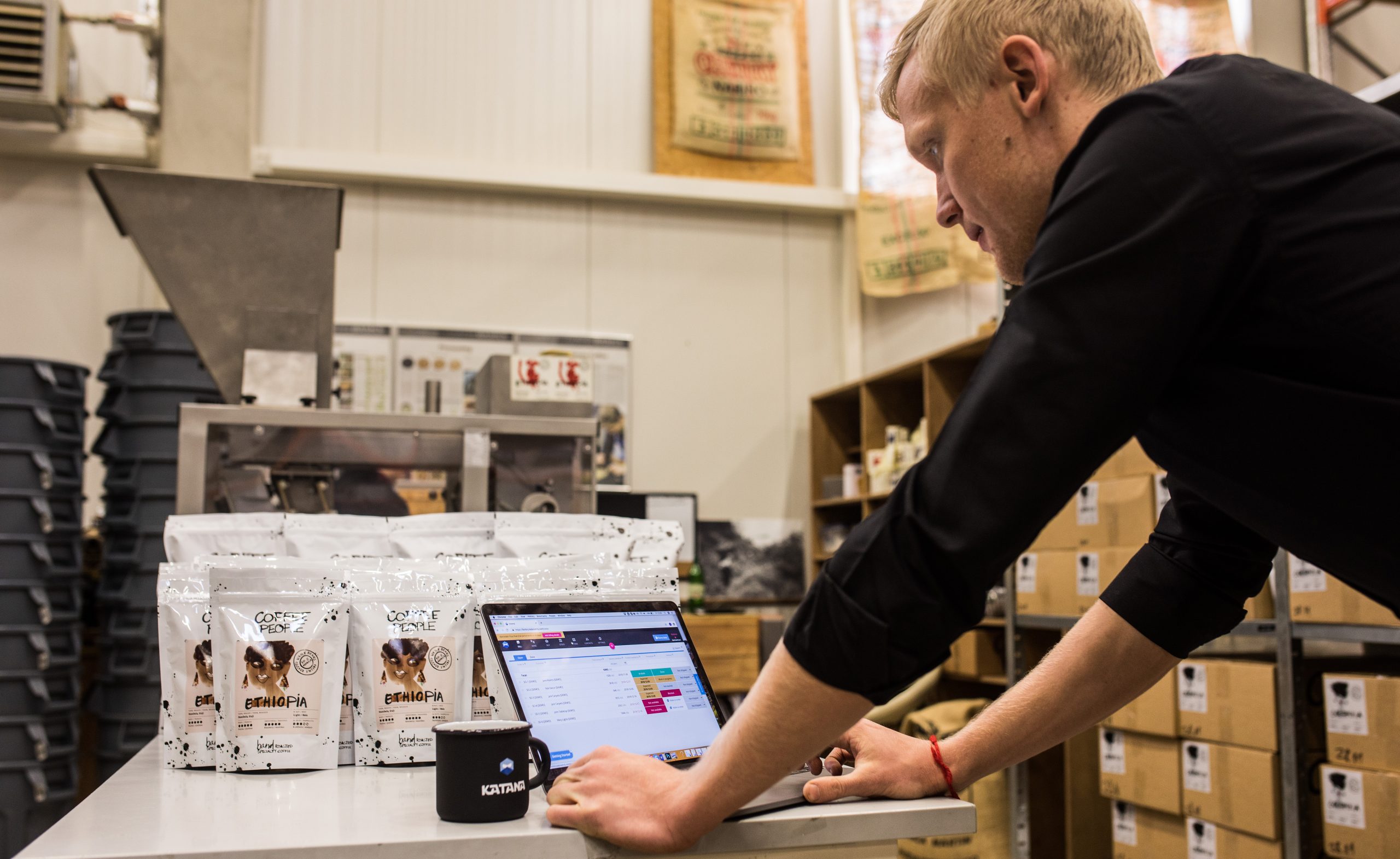How to Move Your Production In-House with Smart Manufacturing
Join Katana’s James Humpreys as he explores how smart manufacturing software can help move production in-house for your D2C ecommerce business!
Written By
Guest Blogger

Since the advent of ecommerce platforms and automated manufacturing, direct-to-consumer (D2C) manufacturers are ditching the traditional methods of selling via third-party and outsourcing their manufacturing, to set-up their own selling channels and take control over their production lines.
One of the reasons D2C has become a popular business model is that customers are opting for the convenience of online shopping and want to shop with businesses that make ethically produced products, too.
In this article, we look into how smart manufacturing tools could help you set up your productions in-house, with 10 steps to success!

#1 Track raw material with inventory management
Inventory management is challenging in any business. But in manufacturing, you have to focus on your raw materials and work-in-progress (WIP) inventory levels too.
Raw material inventory encompasses the total cost of all the materials and parts you have in stock but haven’t committed to production yet.
Raw materials are split into two types:
- Direct material – the materials and parts which form a part of your finished goods.
- Indirect material – the materials and parts which aren’t a part of your finished goods but have costs attached to them, like glue or disposable tools.
Using Smart Manufacturing Software will help you track these costs and inventory levels, in real-time, automatically – helping you understand the carrying costs and manufacturing costs of your goods. You can also set reorder points and safety stock levels, so you can always have the optimal inventory levels to hand.
#2 Create bills of materials
A bill of materials (BOMs) is a document which details the:
- Raw materials;
- Parts;
- Sub-assemblies;
- Intermediate assemblies;
- Quantities; and
- Operations needed to make your finished goods.
When you start manufacturing in-house, you’re going to need to find a way to save your BOMs, the blueprints to your finished goods, so your workers can easily access the document and know exactly how to build your products.
Smart Manufacturing Software not only gives you a place to save these documents, but once you’ve finished setting up your BOMs, the system will read this document every time a manufacturing order is generated, and it’ll automatically:
- Allocate raw materials to production;
- Estimate a deadline;
- Calculate the cost of manufacturing; and
- Assign tasks to workers and workstations.
This will save you time and resources putting together a production plan and schedule, automatically giving you a smooth workflow from the moment a manufacturing order is created.
#3 Plan and control your shop floor
When you get your in-house manufacturing up and running, you’ll need to figure out how to organise your processes all across the business, including your shop floor.
Shop floor planning is the task of developing methods and implementing tools to track, schedule and monitor the status of production.
A smart manufacturing tool will give you an overview of your entire manufacturing business, but also allow you to communicate between you and your workers, so you can track production across:
- The order release;
- Order scheduling; and
- Order progress.
Having shop floor control tools allows you to easily identify problems (or variations) that develop on your production line. And, as Smart Manufacturing Software works in real-time, you can spot issues such as a bottleneck developing. This allows you to make smarter business decisions immediately, to address any problems and improve your production lines on-the-fly.
#4 Keep a production plan and schedule
Production planning and scheduling are going to be essential parts of your day-to-day business, as they make your manufacturing process flow at maximum efficiency.
When working out a plan and schedule for production, the goal is to put together the most efficient workflow that’s devoid of interruptions, delays and stress.
If you’re already working within the manufacturing industry, you’ll know that this task is near impossible to achieve due to there being so many factors that can affect your production lines.
This is where Smart Manufacturing Software comes in. It automates the process of planning your production by scheduling it for you, allowing you to immediately see if you have any production blockers, such as low inventory levels. Not only that, but it will allow you to easily reprioritise manufacturing orders if necessary, redistributing resources to tackle new workflows.
#5 Track multiple sales channels in one place
Multi-channel selling is the approach of selling your products across several sales channels, including:
- Websites;
- Online marketplaces;
- Pop-up stores; and
- Brick-and-mortar stores.
You might be wondering why we’re talking about selling if this article is focused on setting up in-house manufacturing. The purpose of preparing for multi-channel selling is to not only give your business the infrastructure to grow, but to give you the tools to track inventory across multiple locations.
Smart Manufacturing Software can help you centralise your sales channels and warehouses onto one dashboard, so you can track at which location your products are held.
This will give you a smooth workflow, especially useful for make-to-order manufacturers, as you can receive a sales order from a channel, generate and complete a manufacturing order, and then easily dispatch the product down the supply chain to the delivery point.
#6 Monitor manufacturing costs
The total manufacturing cost is the sum of expenses associated with all the resources spent in the process of creating your finished product. Calculating this cost can be a difficult process, as you need to take into account various components when manufacturing a product.
The three major costs components to manufacturing are:
- Direct materials – the raw materials and parts that go into the finished goods;
- Direct labor – the workers who refine, assemble, and manufacture your products; and
- Manufacturing overheads – the expenses of running your production lines, from machinery and rent to indirect materials.
The manufacturing cost formula is as follows:
MC = Raw Materials + Direct Labour + Allocated Manufacturing Overhead
Understanding your manufacturing costs will help you set a fairer price for you and your customers. Smart Manufacturing Software can help you perform these calculations by taking the information from your BOMs, and the specified costs of using resources, to tell you the total manufacturing cost of a manufacturing order.
#7 Keep an eye on any perishable inventory
The manufacturing industry is extremely diverse, and the types of processes or products companies produce vary from factory to factory. That’s why it’s important to know how to handle perishable inventory when setting up your in-house manufacturing. And this isn’t only limited to those who work with food or pharmaceuticals.
Perishable inventory refers to items manufacturers hold and sell, that decrease in value over time, up until the point of becoming worthless.
Smart Manufacturing Software uses product traceability tools to help you easily track the expiration dates on raw materials and finished goods. This mitigates the chances of faulty goods making it onto the market.
Improving your shelf-life management allows you to keep to your production schedules, making sure you’re producing the right amount and the best quality product for your customers.
Perishable inventory tracking will help ensure that you’re stocking ideal inventory levels, retaining more profits, improving cash flow and avoiding recalls.
#8 Automate your manufacturing processes
Adopting production management software along your production line can help in-house manufacturers manage processes, assembly, inspections, inventory management and production planning.
We’ve already touched on the benefits of automation briefly, but it helps D2C manufacturers manage daily, repetitive tasks so they can stay focused on making their goods. Implementing process automation will help you:
- Increase productivity on your shop floor;
- Reduce your labour costs;
- Redistribute resources during shortages;
- Improve product quality checks;
- Reduce your manufacturing lead time; and
- Increase savings with automated processes that would otherwise have to be completed manually.
#9 Map your workshop with ‘routing manufacturing’
Routing manufacturing, also known as production routings, is the process of deciding where your raw materials need to go along your factory floor to become a finished product.
Planning your routing manufacturing means determining the most logical place to set up workstations and inventory, to create a smooth production flow. The advantages of routing manufacturing are:
- Optimal use of available resources;
- Reductions in manufacturing costs;
- Quality improvements; and
- Assistance in planning loading and scheduling.
Smart Manufacturing Software lets you get an overview of your production lines so you can determine the best route to set up on your shop floor.
#10 Set up a smart factory with the right tech
You can set up a smooth workflow from your sales, manufacturing and finances by integrating the tools you’re already using with your Smart Manufacturing Software. For many D2C manufacturers, this has been a formula which has helped them find success:
Ecommerce platform + Smart Manufacturing Software + Accounting tool
Having a smart ecosystem allows you to monitor and gather data from your entire business, giving you a clearer picture of your company’s performance. This will help you make better business decisions.
When you’re set up with Smart Manufacturing Software, your workflow will look a little something like this:
- Ecommerce sales with appear automatically on your manufacturing software;
- You can generate invoices and bills for your clients and suppliers within the software and push it over to your accounting tool;
- You can generate a manufacturing order and complete it; and
- Once you have dispatched the item, you can record the finances and the stock levels will update across all your different platforms and tools.
Bringing everything home with Smart Manufacturing Software
As you can see, Smart Manufacturing Software will not only help you get your in-house production lines set up, but will give you the tools and data to determine the most efficient way to organise your business, from your workflows to the layout of your factory floor.
You can centralise your entire business onto one screen, so you can get an overview of how everything is performing and use real-time analytics to make better business decisions.
If you want to know more about Smart Manufacturing Software, be sure to head over to KatanaMRP.com and take advantage of our 14-day free trial to see how it can help you settle into manufacturing in-house.

